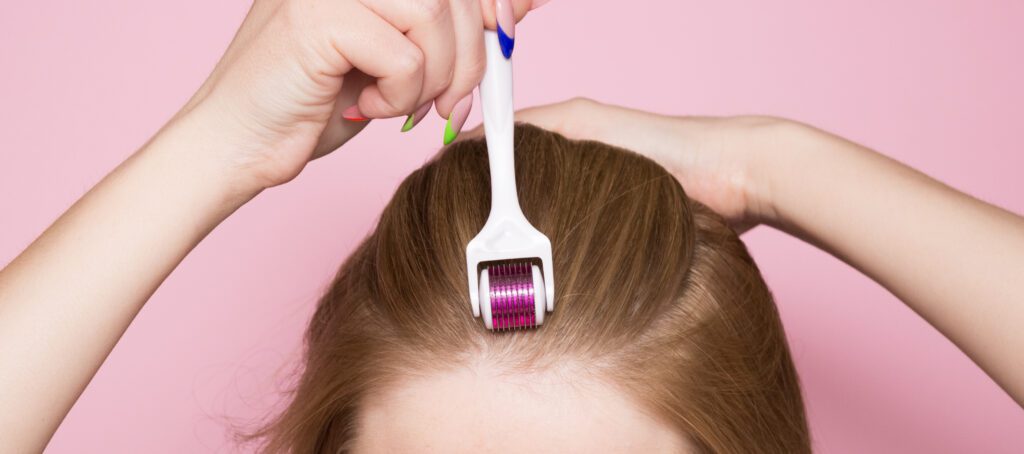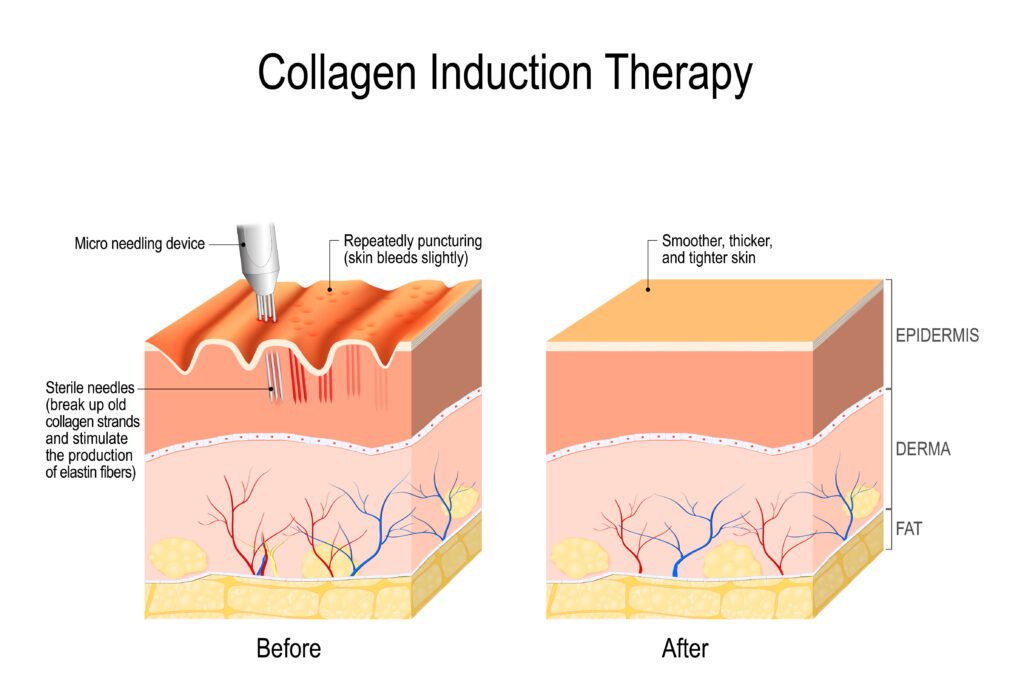Hair loss can be a distressing experience for anyone, regardless of age or gender. While numerous hair loss treatments are available, one intriguing option gaining traction is microneedling. Traditionally used in dermatology for its skin rejuvenation benefits, microneedling is now being explored as a potential treatment for hair loss.

Understanding Microneedling
Microneedling involves using a specialized device with tiny needles to create controlled punctures in the skin, stimulating collagen production. In the context of hair loss, these micro-injuries are made on the scalp to target the hair follicles directly. The goal is to enhance blood circulation, encourage collagen production, and create an optimal environment for hair growth.
Mechanisms of Action
Increased blood circulation and Growth Factors
The scalp responds to the controlled trauma created but the tiny punctures by triggering the body’s natural responses, such as dilation of blood vessels and the release of growth factors, including platelet-derived growth factor (PDGF), epidermal growth factor (EGF) and vascular endothelial growth factor (VEGF). These growth factors stimulate the proliferation of hair follicle stem cells and promote the production of new blood vessels, thereby enhancing the supply of oxygen and nutrients to the hair follicles. The increased and nutrient-rich blood flow provides the environment for improved hair growth.
Collagen production
The controlled trauma caused by microneedling triggers the production of collagen, a vital protein that strengthens hair follicles and improves their capacity to produce new hair growth. By creating tiny punctures skin’s surface, microneedling triggers the body’s natural healing response, stimulating fibroblast cells to produce new collagen fibers. Hair is primarily made of keratin, and collagen contains the amino acids that are the building blocks of keratin. So, by promoting collagen production, microneedling improves hair quality and encourages new hair growth.

Reduced inflammation
Often, inflammation of the scalp and follicles can contribute to hair loss. The therapeutic effects of microneedling may help reduce inflammation, encouraging a healthier scalp environment for hair growth.
Enhanced absorption of topical treatments
Microneedling creates microchannels in the scalp, allowing for better penetration and absorption of topical treatments like minoxidil or botanical hair treatments, optimizing their efficacy in combating hair loss.
Benefits of Microneedling as Hair Loss Treatment
Non-surgical and minimally invasive
Microneedling is a safe and non-invasive procedure compared to other hair restoration treatments such as hair transplantation or surgical procedures. Although hair transplantation surgery is the most reliable way to get fuller hair coverage, only some are willing to undergo surgery for an improved appearance. Micrnoeedling is a good alternative for those who would instead get a much more minimally-invasive treatment for their hair loss. Due to it being minimally invasive, microneedling is also generally safe when performed by a trained professional, with a low risk of adverse effects or complications.
No downtime
Recovery time after microneedling is minimal, allowing individuals to resume their daily activities shortly after the procedure. This is another attractive point for individuals who can’t afford to take a long time off work on have upcoming commitments shortly before the treatment.
Should You Make an Appointment for the Treatment?
Microneedling, a potential hair loss antidote, can be a promising treatment thanks to its ability to enhance blood circulation, promote collagen production, and improve topical treatment absorption. However, it is crucial to remember that individual results may vary, and microneedling should be approached under medical guidanyou’re you’re considering microneedling as a hair loss treatment, consult a trusted professional who can provide a personalized assessment and recommend the most suitable treatment options for your unique needs. Remember, with patience, accurate diagnosis, and the right approach, you can help restore your luscious locks and regain your confidence.
Frequently Asked Questions
How long post-procedure will I see new hair growth?
About 3-6 months after getting a microneedling treatment, you should start seeing some new hair growth in the area of the scalp.
Is microneedling better than PRP for hair loss?
Microneedling is most effective when combined with other treatment options. PRP is one such option that you would benefit from most if you pair it with microneedling.
Can I do microneedling for hair at home?
Although you can buy home microneedling pens, those needles are too short to make a difference in hair loss. It’s best to get the treatment done professionally to notice a significant improvement.
References
- A; FRAJ. Microneedling for the treatment of hair loss? Journal of the European Academy of Dermatology and Venereology : JEADV. Accessed July 6, 2023. https://pubmed.ncbi.nlm.nih.gov/29194786/.
- MA; GAEM. Microneedling for hair loss. Journal of cosmetic dermatology. Accessed July 6, 2023. https://pubmed.ncbi.nlm.nih.gov/34714971/.


